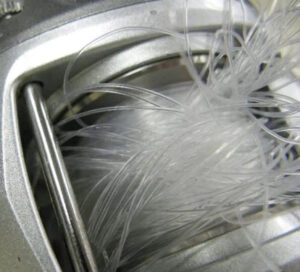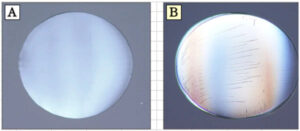
ICast winner St Croix Rods
New St. Croix Legend Tournament Bass GRASP Swimbait rod recognized by the industry as Best New Freshwater Rod at ICAST 2022
PARK FALLS, Wisc. (July 29, 2022) – Advancing and showcasing its mission to handcraft the Best Rods on Earth® that give anglers the upper hand in any angling situation, St. Croix Rod of Park Falls, Wisconsin unveiled an unprecedented 12 new or completely reengineered rod series at ICAST 2022 in Orlando last week.
The 74-year-old family-owned American company was awarded Best of Category honors in the Freshwater Rod category of the ICAST 2022 New Product Showcase Awards for its three all-new Legend Tournament Bass GRASP swimbait models.
The International Convention of Allied Sportfishing Trades’ (ICAST) New Product Showcase Awards recognize the best new fishing products in multiple categories each year. Voted on by attending product buyers and members of the sportfishing media, these “Best of Category” awards represent the pinnacle of achievement in the fishing tackle industry and are fiercely competitive. Winning one of these prestigious awards isn’t easy; it takes good ideas and even better execution to develop a tangible product that helps anglers find more success on the water.
“We’re humbled and honored that those industry professionals who report on or sell fishing tackle for a living selected Legend Tournament Bass GRASP as the best new freshwater rod amidst a packed category, which included 34 other significant new rods from other manufacturers,” says St. Croix CEO, Scott Forristall. “St. Croix is built – top to bottom – to seek out, understand, and serve the needs of anglers; it’s what drives each one of our St. Croix team members every day, so everyone in the St. Croix family feels great pride and a real sense of gratitude for this recognition. Ultimately though, this award is for every angler around the globe who takes as much pride in using a St. Croix fishing rod as we feel in making them. It’s also for our retail partners who are on the front lines of helping anglers choose the Best Rods on Earth® to meet their specific angling needs and objectives.”
The trio of all-new Legend Tournament Bass swimbait models featuring St. Croix’s proprietary GRASP reel seat firmly establishes a new standard in heavy-bass-lure rod design and performance. Designed to excel in the presentation of swimbaits and Alabama rigs from ¾ to 8 ounces, these three all-new swimbait rods bring the newly reimagined Legend Tournament Bass Series to an expansive total of 27 distinct technique-specific high-performance models for the benefit of bass anglers worldwide.
New Legend Tournament Bass swimbait models (LBTC710HF LIGHT SWIMBAIT, LBTC710XHF MID SWIMBAIT and LBTC86XXHFT HEAVY SWIMBAIT) have the distinction of being the first-ever contemporary St. Croix rods released with proprietary St. Croix-designed componentry – in this case, the all-new St. Croix GRASP real seat.
“The angler-requested St. Croix GRASP reel seat helps give anglers the upper hand by delivering superior ergonomic control of Legend Tournament Bass swimbait rods during the cast, retrieve, and throughout fight,” says St. Croix Brand Manager, Ryan Teach. GRASP effectively combats the hand and wrist fatigue that commonly sets in when casting and retrieving heavy lures and doing battle with large, powerful fish. GRASP accomplishes this by always keeping the wrist properly aligned while affording the most comfortable and efficient grip on the rod and casting reel – straight and in line with the rod in the ultimate palming position, not canted back or forward which commonly happens with traditional casting-rod grips. The result is total control over rod and fish, with less fatigue so anglers can fish longer, harder, and earn more success.
In addition to GRASP’s ergonomic design, its angler interface is sweetened with an extremely durable and tactile SoftTouch coating. “The selection of the proper coating took years of discovery and trial and error, and it’s a big part of what makes GRASP distinct in the marketplace,” Teach says. “The SoftTouch coating we landed on is just as important as the refined geometries that make GRASP a complete and unique design. It is incredibly resilient yet remains slightly tacky when wet.”
New Legend Tournament GRASP swimbait models will be available to anglers at St. Croix dealers worldwide and at stcroixrodfactorystore.com in October. All 24 other new Legend Tournament Bass models which were announced earlier this year at the 2022 Bassmaster Classic are available right now.
New Legend Tournament Bass rods feature markedly lighter and stronger next-generation hybrid SCIV+ carbon fiber blanks. Select reaction bait models feature all-new iACT Glass hybrid blanks. In addition to their unique combinations of proprietary materials, all-new Legend Tournament Bass rods also incorporate all of St. Croix’s top technologies and premium components.
While every new Legend Tournament Bass rod is special and distinct, St. Croix Engineering Supervisor, Gavin Falk, says the three iACT Glass models – specifically engineered for hardbait applications like crankbaits and chatterbaits – represent an even greater technological achievement for anglers. “These rods introduce a third material – our linear S-Glass – to the hybrid SCIV+ blank to produce rods with the softer actions reaction presentations demand. We call the combination iACT Glass. It stands for Internally Active, and it allows us to deliver those slower, parabolic actions while maintaining peak sensitivity in a blank that’s significantly smaller in diameter and lighter than a pure glass cranking rod,” Falk says. “Our anglers have asked for this and we’re always listening, not being reactive but addressing ideas and opportunities as they come forward.”
Falk wants to remind anglers that these are not “composite” rods. “All three materials in Legend Tournament Bass iACT Glass models – SCIV carbon, SCVI carbon, and Linear S-Glass – are individually patterned and laid up to spec, then all rolled together,” he says, emphasizing that each of the materials are distinct, and adding that Legend Tournament Bass iACT Glass models are the first carbon/glass hybrid rods ever to be rolled on St. Croix IPC mandrels.
Teach says these three iACT Glass models deliver everything anglers have asked for in a reaction-bait rod and more. “You can even walk a topwater with complete control using one of these Legend Tournament Bass iACT rods,” he says. “That’s not something typically thought to be possible with a rod that has any type of glass in it. You can walk these baits with precision and never even think you have a glass rod in yours hands until you’ve hooked up on a fish and the benefits of that moderate, parabolic action kick in. St. Croix is the only company I’m aware of that’s been able to do this.”
The ‘deepest’ cranking rod in the series with iACT Glass is the POWER GLASS CRANKER LBTC74MHM. “This is a 4/5/6XD cranking rod,” Teach says. “We’ve got an 8XD/10XD/DD22 rod in the lineup, too – the LBTC710XHM – but it’s all carbon. This is a rod Dennis Berhorst and Stephen Browning have become quite fond of. The other iACT Glass models are the LBTC72MM FINESSE GLASS CRANKER designed for smaller squarebills and the LTBC72HM RIP-N-CHATTER, which is optimized for fishing bladed jigs and lipless crankbaits.”
Bassmaster Elite angler, Bob Downey says, “I was very impressed with the lighter weights and significantly reduced blank diameters of these new Legend Tournament Bass iACT rods when compared to a pure glass cranking rod. I’m not aware of anything else remotely like these rods on the market and I found their overall performance with chatterbaits and crankbaits to be in a class all their own.”
MLF angler and crankster, Jesse Wiggins agrees. “I’ve always been a huge fan of St. Croix’s Legend Glass rods – and I still am – but these new blue iACT rods have really impressed me, especially in any cranking situation where you need that extra bit of sensitivity.”
Despite the improvements, some things will stay the same: new Legend Tournament Bass rods remain handcrafted in Park Falls, Wisconsin, USA with a 15-year transferrable warranty backed by St. Croix Superstar Service. They also retain their iconic Tournament Blue Pearl color.
New St. Croix Legend Tournament Bass Features
Next-generation hybrid CARBON FIBER SCIV+ blanks
Technique-specific iACT SCIV+ and linear S-Glass hybrid blanks on specific models
Fortified Resin System (FRS) technology
Advanced Reinforcing TechnologyTM (ARTTM)
Integrated Poly Curve® (IPC®) mandrel technology
Taper Enhancement Technology (TET) blank design
Fuji® K-Series tangle-free guides with Alconite® rings
Fuji® SK2 reel seat on casting models with ergonomic complimenting componentry
Fuji® VSS real seat on spinning models with extended foregrip
Precision machined aluminum reel seat nuts and wind checks on spinning and casting models
Split-grip, super-grade cork handles customized per model
Swimbait models (3) feature GRASP reel seat technology
Full-grip super grade cork handles on select models
Model specific hook keepers selectively placed per technique
Single coat sealer on blank with slow cure finish
Two coats of Flex-Coat slow cure finish on guides
15-year transferable warranty backed by St. Croix Superstar Service
Designed and handcrafted in Park Falls, U.S.A. for bass anglers worldwide
Retail price $290 to $395
New St. Croix Legend Tournament Bass Casting Models
JERKBAITS / LBTC68MXF – 6’8”, medium power, extra-fast action / Retail $295
ALL-IN / LBTC71MHF – 7’1”, medium-heavy power, fast action / Retail $300
FINESSE CARBON CRANKER / LBTC72MHMF – 7’2”, medium-heavy power, moderate-fast action / Retail $315
CARBON CRANKER / LBTC72MHM – 7’2”, medium-heavy power, moderate action / Retail $315
FINESSE GLASS CRANKER (iACT) / LBTC72MM – 7’2”, medium power, moderate action / Retail $315
RIP-N-CHATTER / LBTC72HM (iACT) – 7’2”, heavy power, moderate action / Retail $315
POWER FINESSE / LBTC73HXF – 7’3”, heavy power, extra-fast action / Retail $320
WORKHORSE / LBTC73MHF – 7’3”, medium-heavy power, fast action / Retail $320
FLIP-CHAT-CRANK / LBTC73HMF – 7’3”, heavy power, moderate-fast action / Retail $320
SLOP-N-FROG / LBTC74HF – 7’4”, heavy power, fast action / Retail $325
POWER GLASS CRANKER / LBTC74MHM (iACT) – 7’4”, medium-heavy power, moderate action / Retail $325
WARHORSE / LBTC75MHF – 7’5”, medium-heavy power, fast action / Retail $330
FLIP’N / LBTC76HMF – 7’6”, heavy power, moderate-fast action / Retail $335
BIG CRANKER / LBTC710HM – 7’10”, heavy power, moderate action / Retail $345
*LIGHT SWIMBAIT / LBTC710HF – 7’10”, heavy power, fast action / Retail $350
MAG CRANKER / LBTC710XHM – 7’10”, extra-heavy power, moderate action / Retail $345
*MID SWIMBAIT / LBTC710XHF – 7’10”, extra-heavy power, fast action / Retail $360
POWER FLIP’N / LBTC711HMF – 7’11”, heavy power, moderate-fast action / Retail $340
*HEAVY SWIMBAIT / LBTC86XXHFT – 8’6”, extra-extra-heavy power, fast action / Retail $395
*New at ICAST 2022, available October, 2022
New St. Croix Legend Tournament Bass Spinning Models
PINPOINT / LBTS68MXF – 6’8”, medium power, extra-fast action / Retail $290
DROPSHOT FINESSE / LBTS610MLXF – 6’10”, medium-light power, extra-fast action / Retail $290
VERSATILE / LBTS71MF – 7’1”, medium power, fast action / Retail $300
POWER VERSATILE / LBTS73MHF – 7’3”, medium-heavy power, fast action / Retail $300
DROPSHOT FINESSE XL / LBTS73MLXF- 7’3”, medium-light power, extra-fast action / Retail $300
POWER FINESSE / LBTS73MXF – 7’3”, medium power, extra-fast action / Retail $300
HAIR JIG / LBTS710MLXF – 7’10”, medium-light power, extra-fast action / Retail $335
SWIMMING BAITS / LBTS710MMF – 7’10”, medium power, moderate-fast action / Retail $335
#CROIXGEAR
Like the rods? You’ll love our apparel. Shop now!





